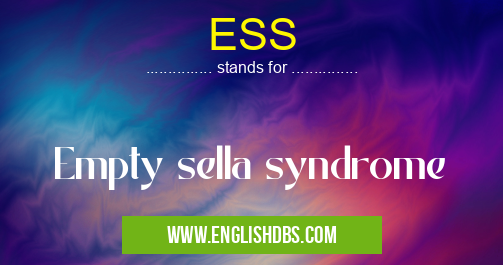What does ESS mean in MEDICAL
Empty sella syndrome (ESS) is a rare disorder of the pituitary gland which affects the brain. The term medical refers to the empty sella, or “sella turcica”, which is a bony structure that encloses and protects the pituitary gland in most people. In ESS, the tissues of this bony structure become weak and thin resulting in an enlarged opening. This allows some of the fluid that normally surrounds and protects the nervous system to accumulate and push on delicate parts of the brain including the pituitary gland. Symptoms can vary widely from person to person, but some common ones include headaches, vision changes, fatigue, infertility, depression and cognitive changes. Diagnosis typically involves imaging scans such as CT and MRI scans to evaluate for a large sella turcica. Treatment involves managing symptoms with medications and lifestyle modifications as appropriate.

ESS meaning in Medical in Medical
ESS mostly used in an acronym Medical in Category Medical that means Empty sella syndrome
Shorthand: ESS,
Full Form: Empty sella syndrome
For more information of "Empty sella syndrome", see the section below.
What Does ESS Mean?
ESS stands for Empty Sella Syndrome, which refers to a condition in which there is an enlarged opening in the “sella turcica” or bony structure which contains the pituitary gland. This enlargement allows a portion of the cerebrospinal fluid that surrounds and protects different parts of our brain to enter into this space creating pressure on delicate parts of our brain including our pituitary gland resulting in varied symptoms.
Essential Questions and Answers on Empty sella syndrome in "MEDICAL»MEDICAL"
What is Empty Sella Syndrome?
Empty sella syndrome (ESS) is a rare disorder of the pituitary gland, which occurs when cerebrospinal fluid (CSF) has filled the space surrounding the pituitary gland. The CSF causes the pituitary gland to become flattened and unable to produce hormones normally. This can lead to various endocrine problems such as infertility and hormone imbalances.
Who is at risk of developing Empty Sella Syndrome?
There is no known cause of ESS, but it has been linked to an abnormal injury or trauma in some cases. It also may occur in association with other medical conditions, including high intracranial pressure or tumors in the brain. Women are slightly more likely than men to develop the condition.
What are the symptoms of Empty Sella Syndrome?
The most common symptom associated with ESS is headaches due to elevated intracranial pressure from the accumulation of cerebrospinal fluid around the pituitary gland. Other symptoms include vision disturbances, depression, low blood pressure, fatigue, and hormonal imbalances including hypothyroidism and low cortisol levels.
How is Empty Sella Syndrome diagnosed?
Diagnosing ESS typically begins with a physical exam and review of symptoms followed by imaging tests such as magnetic resonance imaging (MRI) or computed tomography (CT). These tests allow doctors to detect any enlarged spaces surrounding the pituitary gland that could indicate ESS.
How is Empty Sella Syndrome treated?
There is no specific treatment for ESS; however, certain medications may be prescribed depending on individual symptoms. Hormone replacement therapy may be used for individuals who have hormone deficiencies resulting from ESS. Surgery may also be necessary if there are structural abnormalities in the intracranial cavity that require repair or removal of abnormal tissue or blood vessels.
Can Empty Sella Syndrome be prevented?
Unfortunately, there is no way to prevent EMPTY sella syndrome because its cause remains unknown; however, practicing good health habits such as not smoking and reducing stress levels can help lower your overall risk of developing any type of illnesses or disorders associated with high intracranial pressure levels.
Can someone live a normal life with Empty Sella Syndrome?
Yes! Most people with EMPTY sella syndrome can live normal lives with proper management and medical care for their individual symptoms; however, it’s important for them to stay up-to-date on their hormone levels and monitor any changes in their condition through regular doctor visits for continued care.
Are there any long-term complications related to having Empty Sella Syndrome?
Although there haven’t been many long-term studies done on patients living with EMPTY sella syndrome, some potential effects include increased risk of stroke due to high intralcranial pressures as well as depression due to hormonal imbalance.
Are there additional lifestyle modifications I should make if I have Empty Sella Syndrome?
People living with EMPTY sella syndrome should take precaution by avoiding activities that could put them at higher risk for further brain damage such as contact sports or strenuous physical activity; they should also pay close attention to their body's response during any physical activities they choose and switch over quickly if they feel uncomfortable or experience increased pain.
Final Words:
ESS or Empty Sella Syndrome is a rare condition where there is enlargement of bony structures enclosing our pituitary gland allowing cerebrospinal fluid and pressure to accumulate inside them causing varied symptoms related to this pressure on delicate areas in our brain like headaches, vision changes etc., Treatment usually involves managing each symptom individually with lifestyle alterations along with medications when necessary.
ESS also stands for: |
|
| All stands for ESS |
